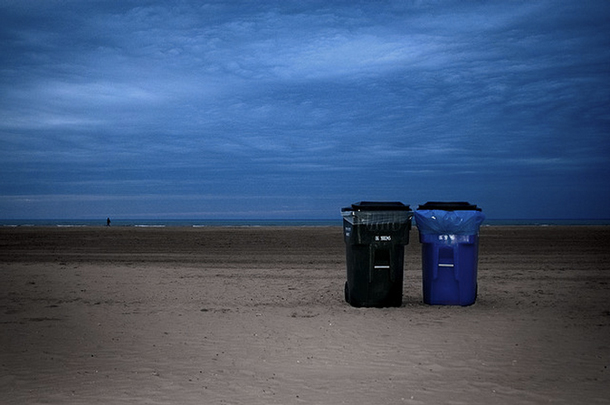Q&A: Recycling industry CEO Sharon Kneiss talks blue bins, and why zero-waste really isn’t
By Chris Bentley

Q&A: Recycling industry CEO Sharon Kneiss talks blue bins, and why zero-waste really isn’t
By Chris Bentley
At a time when environmentalism is as much about high-tech innovation and industrial economies of scale as it is about conservation, recycling seems almost quaint. But what is one of the world’s most widely adopted environmental programs has made considerable strides since it began in earnest during the 1960s. Sharon H. Kneiss is the president and CEO of the Environmental Industry Associations, the trade association that represents the private sector solid waste and recycling services industry.
Chris Bentley: Recycling rates are increasing, but citywide recycling still isn’t a reality in Chicago, the nation’s third largest city. Meanwhile it’s mandatory elsewhere, as in San Francisco, where they also have curbside composting. Are municipally organized systems doomed to be a patchwork of programs, some of which work and some of which don’t?
Sharon Kneiss: Recycling has been developed at the municipal level, but we’ve learned a lot about the tools that they have to promote it. Accessibility is very important. We’ve seen a jump in the amount of municipal solid waste that was recycled when we switched from the little blue bin to the 95-gallon bin. Education is also very important. When you educate you can really encourage people who have access to recycling to participate.
What happened in 1985? The total municipal solid waste recycling rate nearly doubled that year.
In the 80s there was a big jump in recycling because there was concern over landfill space. There was another big jump between 1990 and 1995, because that’s when a number of big groups started to adopt recycling programs. Another significant improvement has happened in the last 10 years. We’ve gone from recycling programs in about 500 communities to about 10,000 communities. It means that there is accessibility for between 58 and 74 percent of the population.
Is municipal waste recycling a good proposition for cities, fiscally speaking?
Recycling has become a culture in this country. It’s really important that you have the markets developed for recycling. Part of the enterprise is to make sure you have a market for the commodities you end up with from recycling: paper, corrugated container board, plastics — some plastics become fleece fabrics, some become part of composite wood, other plastics — paint, aluminum. Recycled aluminum saves 95 percent of the energy it would take to make a new product.
What percentage of recycled goods are actually landfilled?
There have been tremendous improvements in the amount that has been recycled. The vast majority of it is recycled. The technology has advanced to a mind-boggling degree. Curbside, single-stream recycling where you can put all your recyclables in one bin and it’s recycled at a single facility. Almost two-thirds of the population has access to single-stream recycling.
Optical scanners can read recyclables on the line and pick out certain plastics based on its optics. Stereo vision scanners can pick out certain trash based on its shape. The Eddy Current uses magnets to pull away aluminum. If you like mechanics, visiting these facilities is like being a kid in a candy store.
What is a “dirty MRF” and what impact do such projects have?
A “dirty MRF” is where they mix all of the waste with recyclables. There’s some concern about contamination of the recyclables when you’re mixing it with municipal solid waste — there’s only one bin and it all gets sorted after that. I think it’s a greater challenge in terms of separation.

Paper/paperboard waste was nearly three times more abundant by weight than the next most prevalent material (tie: yard trimmings and food scraps), but since 2000 it has started to crash. But isn’t that positive movement masking an uptick in e-waste?
This is really a cultural change, on the paper side. This is what we call the “evolving ton.” Recyclables are changing. We’re seeing less packaging, smaller containers; less glass, more plastic; we are seeing a changing composition.
On the electronics side, there is a growing cadre of recyclers who recover a lot of the precious metal of electronics.
Shouldn’t it be mandatory for more items, given the education issues and public health issues in some cases?
Part of it is educating people. We’ve learned even $1 per household spent on education gets a large return. Some places, like San Francisco, have a recycling requirement and there has been an impact. You need to accompany that with strong education so people understand what goes in and the importance of recycling.
Illinois is one of eight states to cover at least three products with an Extended Producer Responsibility Law (EPR). What impact could these programs have and how likely are they to advance?
One of the most effective programs, in Maryland, is not a requirement — a utility in Maryland has an aggressive program. But in terms of these laws, we don’t know how effective they are. We would urge states considering these laws to look at the whole picture. They need to look at the life cycle, and ensure that they don’t disrupt recycling markets already in place.
Is zero-waste an attainable goal? How can it ever be economically feasible? What does it mean to aim for zero- or low-waste, exactly?
Zero waste doesn’t mean none. Unless you repeal the laws of physics there will be something left. The definition is really somewhat fuzzy. There’s no established and accepted definition of what zero waste is. A lot of companies institute these programs because of the potential cost savings — Subaru, Walmart, Coca-Cola — it’s smart capitalism. It’s reducing waste to the degree that is economically feasible.
You note that the recycling supply chain has become more environmentally sustainable — fleets use alternative fuels, mechanized sorting and screening are more efficient — but is the life-cycle analysis still worth it in terms of greenhouse gas emissions?
The waste management industry is leading the way in natural gas-powered cars. We capture a lot of that gas from landfills. The savings is tremendous. Right now we have between 4-5,000 such vehicles on the road. Almost half of the newly produced trucks for the fleet run on natural gas. Of course there’s an infrastructure cost around that, but many have put in natural gas refueling stations.
Do you think recycling is popular because it represents a no-cost, out-of-sight way for consumers to feel like they’ve had an impact, when in reality they may be consuming too much in the first place? Shouldn’t the focus be on reducing consumption or at least reusing goods?
Some experts have called recycling the most effective environmental program in the world — it’s the most widely accepted program, because it’s become easy for people to do. We still have a ways to go, but it’s now accessible to 10,000 neighborhoods. There has been a focus on reducing packaging upfront. We are seeing those opportunities.
The area where they’re really starting to look at reductions is food waste. Organics is the next frontier in recycling. They’re also much harder because there are a lot of liquids and what we call “putrescibles.” Many retailers are looking at ways to reduce that by donating perishable goods before their expiration dates.
Even with all the improvements we’ve discussed today, how big of a role does recycling play in a sustainable industrial society? Describe your ideal view of the industry as your children will know it.
It’s probably beyond my imagination. The advancements in recycling have moved forward at an amazing speed. When I visited a facility recently, the manger said he had to update his equipment once a year, but if he really wanted to keep up he could probably change it once a month. The technology is allowing a lot more to be recycled a lot faster.
That doesn’t mean we don’t have a long way to go. Commercial and demolition debris is improving, and we’re finding new markets. You can’t just collect products for recycling — you have to have a market the product can go to. For organic waste, we’re looking at processing that into methane and other gases. There’s a lot of exciting potential opportunities.
One thing I was fascinated by when I first came to this industry is that companies don’t look at waste as trash. They look at it as a raw material to extract value from.
Any takeaway lessons for the near-term?
Single stream has been the key to expanding recycling. Privatization, quite frankly, has really helped. It has developed large, regional facilities quite quickly in a way that generally governments don’t do. It has also lowered costs. Advancements in truck technology has made collection more efficient and safer.
The waste industry is an industry in transition. Since 2000 all of the increase in waste has been matched by an increase in recycling. That doesn’t mean challenges don’t remain in the collection and the economics — we still need recycling at multi-family housing, and price volatility impacts the economics.

